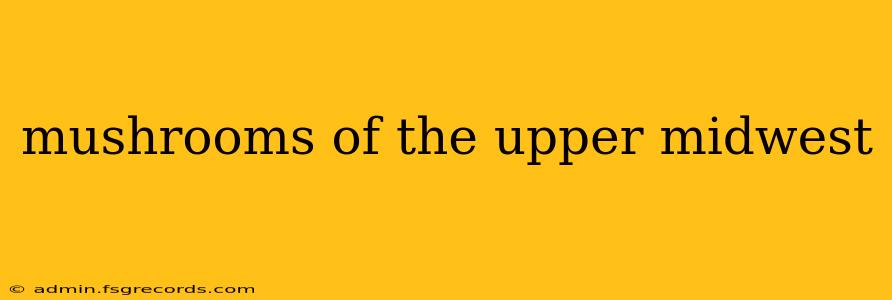The Upper Midwest, with its diverse forests and varied climates, boasts a rich bounty of wild mushrooms. From the vibrant chanterelles of hardwood forests to the earthy morels of spring, this region offers a fascinating and potentially rewarding experience for amateur and experienced mycologists alike. However, mushroom hunting requires caution and knowledge; misidentification can have serious consequences. This guide provides an overview of common Upper Midwest mushrooms, emphasizing safe foraging practices.
Identifying Common Upper Midwest Mushrooms
This section highlights some of the most frequently encountered edible and poisonous mushrooms in the region. Remember, this guide is for informational purposes only and should not be used as a sole source for mushroom identification. Always consult multiple reliable sources and, when in doubt, do not consume a mushroom.
Edible Mushrooms:
-
Morels ( Morchella species): These prized spring mushrooms are characterized by their honeycomb-like caps. Several Morchella species are found in the Upper Midwest, often near ash trees or disturbed ground. They require careful cleaning before cooking.
-
Chanterelles ( Cantharellus species): Known for their vibrant yellow to orange color and funnel-shaped caps, chanterelles are a delicious addition to many dishes. They often grow in clusters in hardwood forests. Look for true chanterelles, which have forked gills rather than the flat gills of some poisonous look-alikes.
-
Oyster Mushrooms ( Pleurotus ostreatus): These shelf-like mushrooms grow in clusters on decaying wood, particularly hardwood trees. They are relatively easy to identify and have a mild, oyster-like flavor.
-
Chicken of the Woods ( Laetiporus sulphureus): This striking mushroom has bright orange to yellow, shelf-like fruiting bodies. It is found growing on trees, often oak. Important note: Always thoroughly cook Chicken of the Woods before consuming as some individuals have reported digestive upset.
Poisonous Mushrooms:
-
Death Cap ( Amanita phalloides): This extremely poisonous mushroom is responsible for the majority of fatal mushroom poisonings worldwide. It's often found near oak trees and has a pale green or white cap. Never consume any mushroom with a volva (cup-like structure at the base of the stem).
-
Destroying Angel ( Amanita virosa): Another deadly Amanita species, the Destroying Angel has a white cap and is often found in coniferous and deciduous forests. Its toxins are also extremely potent.
-
Jack-o'-lantern Mushrooms ( Omphalotus illudens): These bioluminescent mushrooms grow in clusters on wood and have bright orange caps. They can cause severe gastrointestinal distress.
Safe Mushroom Foraging Practices:
-
Learn from Experts: Take a guided mushroom foraging walk with a knowledgeable mycologist. This is the best way to learn proper identification techniques.
-
Use Multiple Identification Sources: Never rely on a single field guide or online resource. Compare your findings with several sources before consuming any mushroom.
-
Start with Easy-to-Identify Species: Begin with well-known and easily identifiable edible mushrooms like oyster mushrooms or certain chanterelles before venturing into more complex identifications.
-
Take Spore Prints: Spore prints can be crucial for identification; they show the color of the spores produced by the mushroom.
-
When in Doubt, Throw it Out: This is the most important rule of mushroom foraging. If you are unsure of a mushroom's identity, do not eat it.
-
Harvest Responsibly: Only collect what you need and harvest mushrooms sustainably. Leave some behind to ensure the continuation of the mushroom population.
-
Cook Thoroughly: Some mushrooms, even edible ones, require thorough cooking to reduce potential toxicity.
Expanding Your Mycological Knowledge:
The Upper Midwest offers a wealth of mycological diversity beyond the mushrooms mentioned here. To further your knowledge, consider joining a local mycological society, attending workshops, or purchasing comprehensive field guides specific to the region. Remember that responsible foraging requires ongoing learning and a commitment to safety. Happy hunting!

